The Microsoft Surface Book 3 (15-Inch) Review: A Refreshing Dip Into Ice Lake
by Brett Howse on June 3, 2020 9:00 AM ESTBattery Life
One of the advantages of the Surface Book design is that it offers up a significant amount of space for battery cells, with around 22 Wh in the tablet, and another 63 Wh in the base, adding up to 85 Wh total capacity. But battery capacity is only part of the equation, with platform efficiency also being as important.
To test the battery life of the Surface Book 3, the display was set to 200 nits, and the total time was measured to discharge a 100% charged device in a couple of scenarios. We’ve dropped our old light test, since the workload was almost an idle time for modern devices, and will now be testing our heavy web workload, movie playback, and new to this review, the PCMark 10 Modern Office Battery life test.
Web Battery
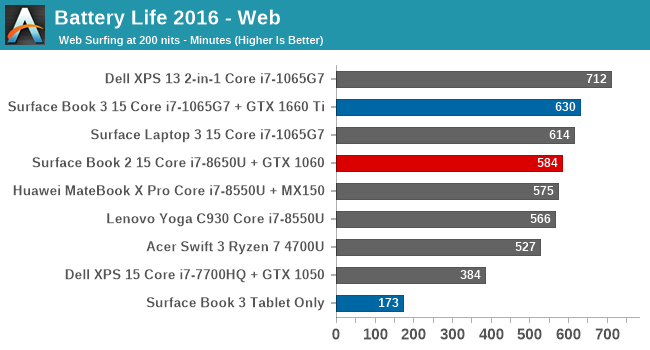
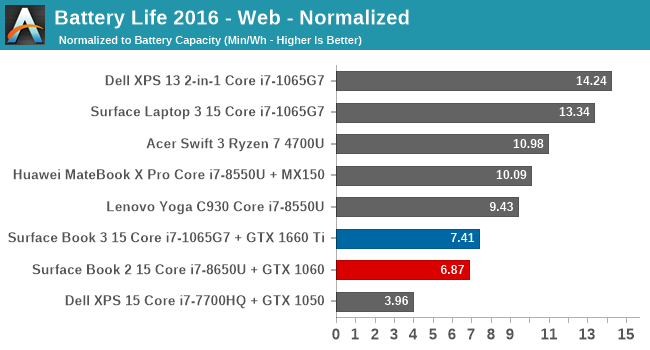
The extra battery capacity certainly helps the Surface Book 3 maintain all-day battery life. Despite the large, high-resolution display, the Surface Book 3 offers particularly good battery life at 10.5 hours on this test. It achieved 46 minutes more runtime than the Surface Book 2, and since they both share the same display, likely points to the efficiency gains of the new Ice Lake processor under load. There are devices that can achieve longer battery life, but since so much of the power draw is the display, they tend to have much lower power 1920x1080 offerings.
Movie Playback
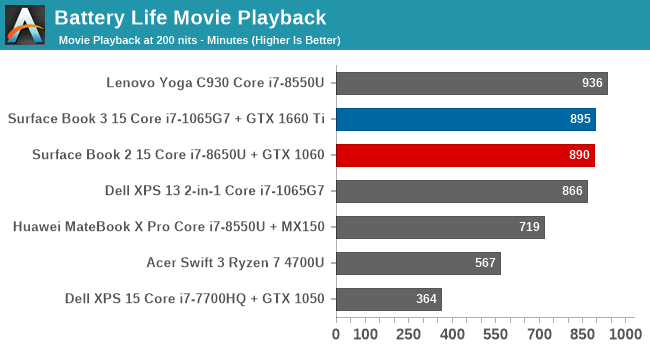
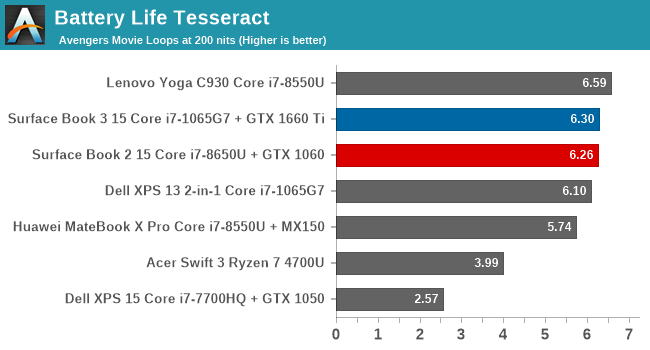
Movie playback tends to be one of the best ways to achieve battery life, since the video decode is offloaded to fixed-function hardware in the media block which can be very efficient. The Surface Book 3 achieves almost 15 hours of battery life in this test, outperforming the previous model by five minutes. Very impressive.
PCMark 10 Modern Office
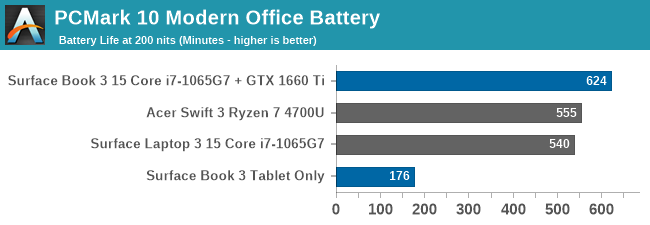
Adding in a new test means we unfortunately don’t have the backlog of data from previous devices, so for now please accept this smaller comparison. The large battery once again does what it intended, offering almost 10.5 hours here as well. The Modern Office battery test runs three scenarios, each at ten minutes in length. If a device finishes the test sooner, it will idle until the ten minutes is up, so faster devices will be able to get into the “hurry up and wait” stage which should be a benefit in this test.
Platform Power
The big 15-inch high-resolution display accounts for a big chunk of the Surface Book 3's power draw. With the display at the same 200 nits brightness we test at, measured power draw of the system was around 6.5 Watts, but with the display off, idle power draw dropped to as low as 650 mW, which is very impressive. Microsoft has certainly done their homework. That means the display accounts for almost six watts of draw at 200 nits. High DPI has its price, and that is battery life.
Also of note, the Surface Book 3 will disable the discrete GPU if the battery falls below a certain percentage, which seems to be around 8-10% charge. This was confirmed as by-design, and the NVIDIA GPU will no longer show up in device manager until the device is charged and rebootted.
Charge Time
Microsoft includes a 127-Watt AC adapter with the new Surface Book 3, which will prevent it from discharging under load like the previous model could, but as with most devices, the amount of power you put into the battery is never that high. If you need to charge the laptop on the go, it can also be charged over the USB-C connector, although you won’t achieve the power provided by the included adapter.

Interestingly, with the batteries split into two sections, you would think Microsoft would be able to charge the Surface Book quicker than most other devices, but they are pretty conservative with the power going back into the battery, likely to increase battery longevity. As such, charging from empty still takes over 2.5 hours.










125 Comments
View All Comments
Deicidium369 - Friday, June 5, 2020 - link
I'm saying that Dell builds what sells - they are pretty good at it. I would never buy a Dell desktop or workstation - but for ultrabooks / 2-in-1s and monitors - I am pretty well in the Dell camplmcd - Thursday, June 4, 2020 - link
Oh come on if you spent more than 10 seconds on Dell's website you'd know why.Dell is a corporate company through and through and every one of their laptops supports a dock. Dell docks are 90% TB3 docks. Integrating TB3 with AMD is possible but not easy right now. The turnaround time would be impossible for this laptop launch cycle.
Spunjji - Thursday, June 4, 2020 - link
This reply makes no sense WRT their gaming designs, though.lmcd - Thursday, June 4, 2020 - link
That's a fair critique, but the only gaming designs we've seen are ASUS, no? They were the preferred partner. Don't think AMD has enough "preferred partner" teams to hit up every laptop brand.Retycint - Thursday, June 4, 2020 - link
Did you not read his comment at all? Longer lead times, due to customized components etc. Not to mention the perceived brand differences in average consumers' mindslmcd - Thursday, June 4, 2020 - link
Why did you even reply if you can't read the comment? "And premium laptops have a longer lead time than simpler value and gaming designs."Fataliity - Sunday, June 14, 2020 - link
Renoir only came out 3 months ago. Lead times, especially for redesigning for a new motherboard and all, are about 12 months.Plus Intel has a lead in the size of their motherboard form factors for devices like this. It's not just the processor.
Spunjji - Thursday, June 4, 2020 - link
Microsoft put AMD's last-gen chips in some of their premium devices. It's almost like they already very pointedly developed the ability to second-source even when performance leadership wasn't there...(I can actually understand them not doing so in this specific instance. They barely got their drivers functional for the Intel / Nvidia combo, I don't think they'd have a good time redoing the whole thing for AMD)
We already know that Tiger Lake is a 4-core part at 15W (TDP-down from 28W), so I guess we'll see how things look in a year's time.
Deicidium369 - Friday, June 5, 2020 - link
Would there be significant changes between that APU vs the 4000 series? Can't imagine MS doing it for no reason - but there are pretty long lead times ... that's a bit of a halo (no pun intended)product for MS.Spunjji - Friday, June 5, 2020 - link
I genuinely don't know the answer to that. The desktop models are going to be compatible with the same socket and chipset, so I wouldn't have thought they'd need to do an extensive redesign moving from 3000 to 4000 series APUs - but then 4000 enables the use of things like LPDDR4X, so I may be entirely wrong.It's taken MS long enough to refresh this product that I'm sure you're right about the lead times.